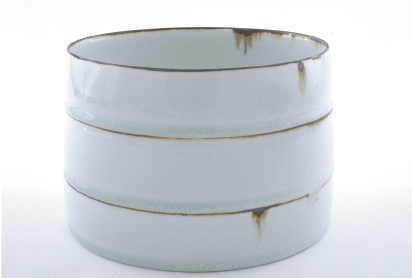Kirsten Coelho — Studio Potter
There have been many changes over the years in the terms used to describe those who find personal expression in the manipulation of clay. The November 2005 exhibition by Kirsten Coelho at the BMG Gallery in Adelaide provides a welcome opportunity to write about the work of someone who fits – quite precisely – a currently underused epithet, that of 'studio potter'.
In these days of ceramicists (a word, predictably enough, recognised by Microsoft Office 2000 spell-checker) ceramic artists (flesh and blood, really) designer-makers with a ceramics-based practice, and a dwindling number of potters, the term studio-potter is refreshingly transparent. We understand immediately an engagement with a discipline that constitutes one of the core traditions of 20th century craft; one which is, thankfully, still alive and well in the new millennium. Kirsten Coelho is an exponent of such an approach, where late-nineteenth century European sensibilities met a thousand years of North-Asian ceramics to create an idiom which whilst finding a home in craft, could reach out with one hand and touch art, and with the other the practical world of industry. None of this describes what Coelho’s pots are like, but it helps in understanding where they come from; what they are, and what they are not.

bowl h.7.5cm, d.26cm, vase h.24cm.
Photo: Grant Hancock
If one had to cite the antecedents of Coelho’s work the names would be unsurprising. There is an element of Lucie Rie, of Sung and T’ang pottery, even of Gwyn Hansen-Piggott, though without recourse to the device of still-life. She has chosen impeccable models, and in adding her own voice to this lineage of quietude, the message is carried forward, altered and enriched.
Coelho’s pottery is now recognisable, and in this exhibition these familiar themes are restated and refined. The straight-sided bowl, small cups and tapering vases, along with newer essays in form; a long-necked bottle and tall lidded-jar, both of which acknowledge their Chinese ancestry whilst living very much in the here and now. The clay is porcelain; the glazes variations of celadon, temmoku, copper-red, and an unctuous white which ranges in surface quality from silken-matt to being slightly glassy and reflective. It is mostly to this white glaze that Coelho has added touches of iron, just a spot or thin line, which lightly pulls at the waist or touches the lip. These marks address the form so intimately that I would hesitate to describe them as decoration; they are more a kind of visual punctuation, giving lift and cadence to the object.
Interestingly, Coelho often refers to these marks as coming from her observations of corroded metal, especially the ubiquitous galvanised-iron rainwater tank that, together with a Eureka lemon tree, was found in most Adelaide back yards before the heady days of gentrification and urban infill. Her home-studio in an old workers cottage is in an area of the city where industry has also left its share of detritus. This may seem an unexpected source of inspiration for the beauty of porcelain, yet the district’s history as a port adds a layer of complexity, as this fragile substance has a long history of trade.

Coelho has recently been awarded an Australia Council residency in London, a city where she has spent many years and to which she owes much of her ceramic development. It seems only fitting that she returns there periodically, as there is a sensibility about her work that is very English. Not the England of Cool Britannia & YBA’s, and certainly not the England of Grayson Perry, which, despite the noise and clamour for attention, is only a very small part of the whole. I suspect Coelho’s London touchstones are to be found in the Victoria and Albert, the Percival Pavid Foundation or Gallerie Besson, rather than in the Saatchi Collection or Tate Modern. And, away from the city, there are still many potters of note, who, like Richard Batterham, pursue their profession, making objects of simple beauty and unquestioned authority.

Photo: Jim DeGregorio
This is not to say that this approach to ceramics is nostalgic or stultifying, or that it has failed to happily assimilate ideas, styles and techniques from many different places. It is more about the pace at which change takes place, and a healthy scepticism of change for changes sake. In the tradition of which Coelho partakes you only take a step forward when you are sure you understand the last. The past is not seen as something to be challenged and defeated; it is instructive, and therefore nurturing. The territory it occupies, between art and industry, is exactly where it wants to be, because it constructed, or at least redefined, this in-between place. Despite the odd revisionist declarations of a new breed of craft theorists, its engagement with multi-culturalism has often been marked by a degree of respect and sensitivity that the fine-arts can only dream about.
All of these things may be found to varying degrees in the best studio-pottery, and they are to be found in the work of Kirsten Coelho.
Damon Moon
Willunga 2006
